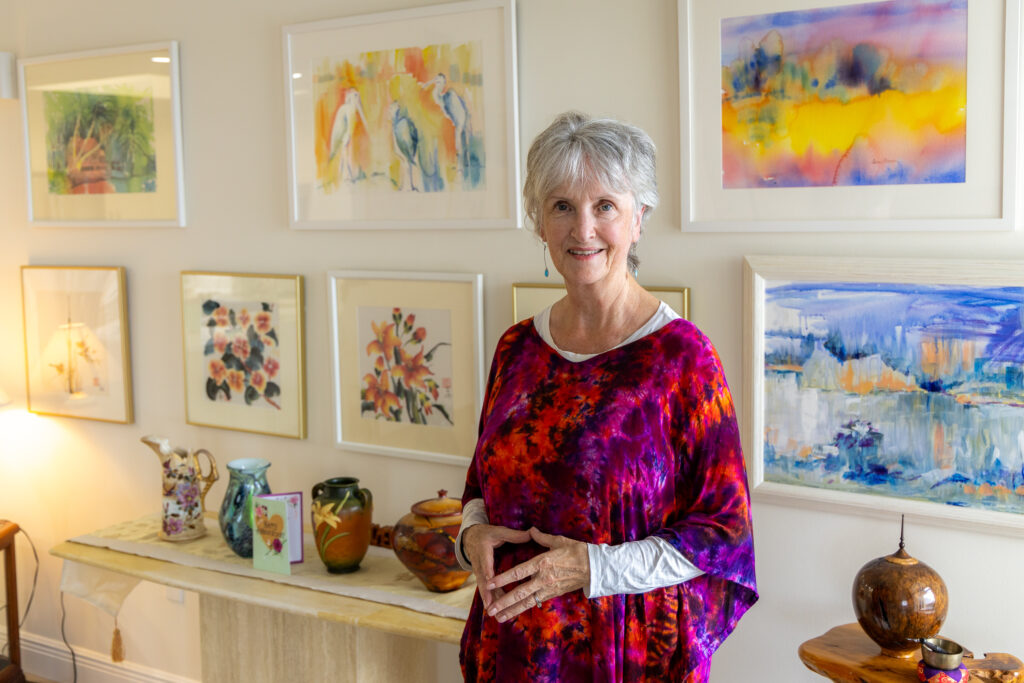
To say that art has played an important role in Sue Beavers’ life would be a major understatement. Born and raised in a small town in the central part of Wisconsin — the third oldest of 11 children — she began drawing at a young age. “I enjoyed drawing portraits of my family members,” she recalled. “My Dad was very supportive. He always complimented me on my drawings.”
Sue earned her bachelor’s degree from The University of Wisconsin- Stevens Point and a master’s degree in Art Education from The University of Wisconsin in Madison. She wrote her master’s thesis on the Hmong art and culture, using information from the parents of students she met. Her thesis gained her recognition in “Who’s Who in American Women.”
“I have always loved all things Asian,” Sue explained, “and, starting from when I was very young, my art teachers said my art work resembled Japanese art.” Years later, as a high school art teacher, she taught Vietnamese and Hmong refugees from Southeast Asia.
Teaching has always played an important part in Sue’s love for art. She had a 30-year career teaching art, beginning in middle school and moving on to high school and, eventually, elementary school. “I loved teaching,” Sue declared. “I loved seeing the students grow. If they couldn’t do well in academics, some of those kids were really good in art and they just beamed. The process was more important to me than the product. I didn’t care if they weren’t Michelangelo, but if their confidence grew, that was what was important.”
Sue received confirmation of the positive impact she had on her students, from an email a man posted on the internet in response to the announcement about the class she was teaching at Alliance for the Arts. It read, in part: “I am a past student of Mrs. Susan Beavers (by past, I mean about 4 decades ago!)… I always remember her as one of the kindest, most patient and talented teachers I’ve had along the way…” Sue recalled that she taught both him and his mother.
Sue’s love for teaching art, and her interest in Asian culture, continued when she and her husband Phil moved to Florida. While attending an Open House, she went to their art room, where a woman was teaching a form of Japanese art known as Sumi-e — using a book by Yolanda Mayhall, who lived in Dunnellon, Florida. Sue contacted Yolanda, took classes from her, practiced, and, in 2001, contacted the Art League of Bonita Springs and asked to teach Sumi-e there. They were happy to include it in their program to help loosen students’ approach to painting. In 2003, she also started teaching Sumi-e at the Alliance for the Arts. She continued to teach at both locations until 2021.
“Although Sumi-e, which means ‘ink painting,’ is not easy,” Sue explained, “The simplicity and spirituality is what attracts people to it. The basic concept behind it is four brush strokes called the ‘four gentlemen.’ It is believed that, if one can paint them, one can paint anything in the universe, with the goal of capturing the energy or spirit of the object. Combined with impressionistic watercolor, it is a light, spiritual and impressionistic way of painting. One observes nature, then goes to their studio to paint the spirit of the object.”
Sumi-e has become an important part of Sue’s life. In addition to her many paintings, she uses it to keep a daily journal, often enhancing her paintings by adding her thoughts associated with them in the form of Haiku poetry.
Sue and her husband Phil moved from their home at the Forest Country Club to Cypress Cove on March 11, 2024 and are happy with their choice. “ I don’t ever feel like going anywhere because they have everything you need right here,” Sue commented. “Everyone is so friendly and positive.” And, not surprisingly, Sue is already sharing her love for art and teaching with fellow residents.
By Donna Miceli (Cypress Cove Resident)

